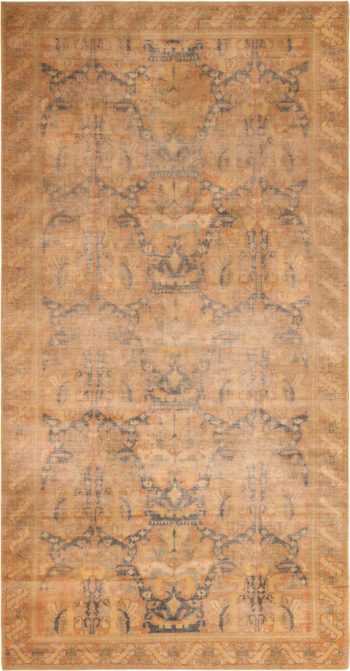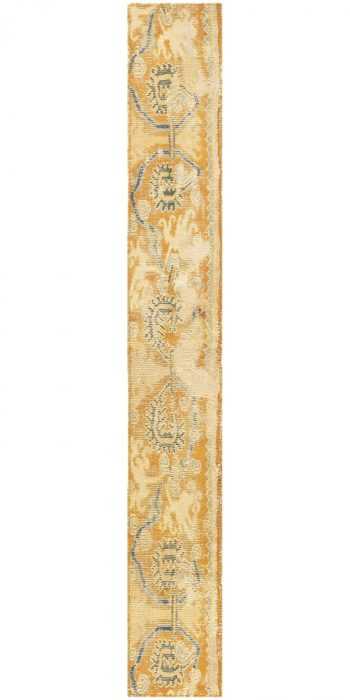Cuenca Rugs From Spain
Heritage Elegance: Spanish Cuenca Rugs For The Connoisseur
View our current selection of Spanish antique Cuenca rugs:
Antique Spanish Cuenca Rug 71431
$28,500.00Size: 7 ft 4 in x 14 ft (2.24 m x 4.27 m)16th Century Antique Spanish Cuenca Fragment 3432
$1,450.00Size: 2 ft x 6 ft 2 in (0.61 m x 1.88 m)
Learn More About Antique Spanish Cuenca Rugs
What are Cuenca rugs?
Cuenca rugs refer to handmade rugs that originate from the city of Cuenca in central Spain. Similar to Alcaraz rugs, Cuenca rugs are known for their traditional craftsmanship and intricate designs.
Here are some key features of Cuenca rugs:
- Handmade Craftsmanship: Cuenca rugs are crafted using traditional handweaving techniques. Skilled artisans employ these methods to create unique and often elaborate designs.
- Designs and Patterns: Cuenca rugs typically feature a variety of designs, including geometric patterns, floral motifs, and other intricate elements. The designs are woven into the rugs with careful attention to detail, creating visually appealing and distinctive pieces.
- Colorful Palette: These rugs often incorporate a vibrant and diverse color palette. The use of rich and varied colors enhances the aesthetic appeal of Cuenca rugs, making them suitable for both decorative and functional purposes.
- Materials: Cuenca rugs are traditionally made using natural materials such as wool. The choice of materials contributes to the durability and quality of the rugs.
- Cultural Heritage: The art of rug weaving in Cuenca has a long history, reflecting the cultural heritage of the region. The tradition of crafting these rugs has been passed down through generations, preserving the cultural and artistic identity of Cuenca.
- Collectability: Like Alcaraz rugs, Cuenca rugs are often collected as art pieces. Their craftsmanship, unique designs, and regional authenticity make them desirable for collectors and those interested in traditional handwoven textiles.
The specific characteristics of Cuenca rugs can vary, as individual artisans may bring their own creativity and style to the craft. As with Alcaraz rugs, the term “Cuenca rugs” refers to rugs produced in the Cuenca region, and the style may vary within the broader tradition of Spanish rug making.
When did rug weaving start in Cuenca?
The tradition of rug weaving in Cuenca, Spain, has a history that dates back several centuries. While it is challenging to pinpoint the exact starting point, rug weaving in Cuenca is known to have been a significant and longstanding craft.
The medieval period in Europe, which spans from the 5th century to the late 15th century, was a time when various artisanal crafts, including rug weaving, thrived in different regions. It is likely that the tradition of rug making in Cuenca has roots in this historical period or even earlier.
Over the centuries, the art of rug weaving in Cuenca has been passed down through generations, with artisans preserving and refining the traditional techniques. The cultural and historical context of Cuenca has influenced the designs, patterns, and styles of the rugs produced in the region.
While specific historical records may be limited, the continuity of rug weaving in Cuenca speaks to its deep-rooted heritage. The craft remains an integral part of the cultural identity of Cuenca, and the rugs produced there continue to be valued for their craftsmanship and unique aesthetic qualities.
What makes Cuenca rugs so special?
Cuenca rugs from Spain are considered special for several reasons:
- Traditional Craftsmanship: Cuenca rugs are handwoven using traditional techniques that have been passed down through generations. The artisans in Cuenca take pride in their craftsmanship, employing skills and methods that have historical significance.
- Intricate Designs: These rugs are known for their intricate and diverse designs. Geometric patterns, floral motifs, and other detailed elements are often incorporated into the weaving, showcasing the skill and artistry of the craftsmen.
- Vibrant Colors: Cuenca rugs typically feature a rich and vibrant color palette. The use of bold and varied colors adds to the visual appeal of the rugs, making them stand out as decorative pieces.
- Cultural Heritage: The tradition of rug weaving in Cuenca has a long history, reflecting the cultural heritage of the region. The designs and patterns often carry cultural significance, connecting the rugs to the identity and history of Cuenca.
- Quality Materials: Cuenca rugs are traditionally made using natural materials, such as wool. The use of high-quality materials contributes to the durability and texture of the rugs, ensuring their longevity.
- Regional Authenticity: The term “Cuenca rugs” specifically refers to rugs produced in the Cuenca region of Spain. The regional authenticity adds a unique touch to these rugs, and they are often seen as representative of the artistic traditions of that specific area.
- Versatility: Cuenca rugs are versatile in their use. While they are appreciated as traditional art pieces, they can also serve functional purposes, adding warmth and character to living spaces.
- Collectability: Due to their craftsmanship, unique designs, and cultural significance, Cuenca rugs are often collected as valuable and meaningful art pieces. Collectors and enthusiasts appreciate them for their historical and artistic value.
Overall, the combination of traditional craftsmanship, intricate designs, vibrant colors, cultural heritage, quality materials, regional authenticity, versatility, and collectability makes Cuenca rugs special and highly prized in the world of handmade textiles.
More about the antique Cuenca rugs from Spain
The art of carpet making dates back millennia, likely originating with nomadic peoples of central Asia. Utilizing wool sheared from their sheep, it is here that the craft of weaving — an essential part of carpet making — was developed. Woven wool in the form of carpets proved a warm and attractive replacement for the use of animals skins.
Although the more streamlined carpet productions originated in Asia and carpets from that region were imported from their earliest development, carpet making techniques spread throughout Europe. This spread was spurred by numerous factors, likely including the long-standing presence of Moors, who were Islamic immigrants, in modern-day Spain and Portugal.
Though other European countries are more often associated with the making of antique rugs , Spanish rugs are perhaps the oldest European rug tradition owing to the presence of the Moors. The techniques imported by the Moors, however, were quickly adopted by native Spanish speakers.
The Spanish carpet making tradition differed from others in Europe at the outset, featuring a knotted rather than looped weave. Rows were also staggered rather than superimposed. The use of colors also varied, with pastel greens and yellows against ivory grounds.
During the period of the Spanish Empire, the city of Cuenca became known for its carpets starting around the 17th century. Antique Cuenca carpets from Spain were a departure from the Alcaraz carpets of the 15th & 16th century; Cuenca carpets were generally made coarser and with a heavier body.
During the 17th century, Spain’s carpet making industry suffered an intense blow due to an economic depression as well as the expulsion of Muslim and Jewish artisans. Rich patrons stepped in to save the craft, but this intervention resulted in Spanish carpets taking on more influence from England and France.
Cuenca was a dominant producer of carpets in Spain during the 17th and 18th centuries. A royal workshop in Madrid sponsored by the Spanish monarch was created in the 18th century, promulgating designs with French influence. To stifle unwanted competition with the royal workshop, King Carlos IV halted production of carpets in Cuenca by decree in the late 18th century.
Antique Spanish Cuenca rugs experienced a spike in popularity in the 20th century, particularly during the 1920’s. This was spurred in large part because of the demand for Spanish-style houses in California and Florida in the United States. John and Florence Magee, a wealthy couple who resided in Palm Beach, Florida, possessed “the largest variety of Cuenca carpets” in the entire United States, as noted in a 1925 article in Arts and Decoration magazine.
According to Architectural Digest, which used online auction histories as a guide, the color palettes of Cuenca carpets are “earthy and approachable, often with honey yellows, coral pinks, tawny oranges, and slate blues.”
Antique Spanish carpets, including those from Cuenca, are prized among many collectors to this day. Simon Franses, a London dealer and co-founder of the Franses Tapestry Archive — the world’s largest academic resource on European tapestries and similar textiles — has noted that while antique Spanish Cuenca rugs are a niche market “they are quite lovely”.


